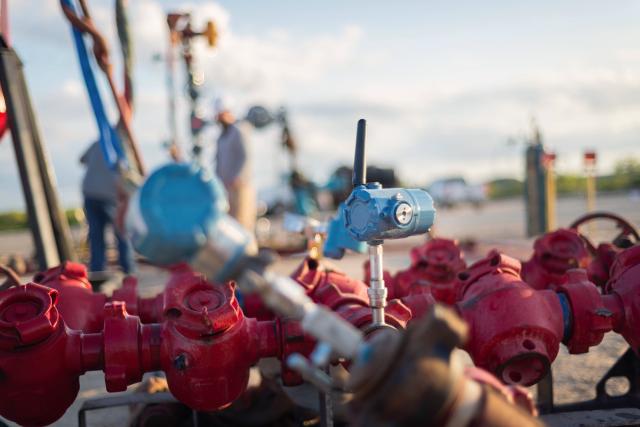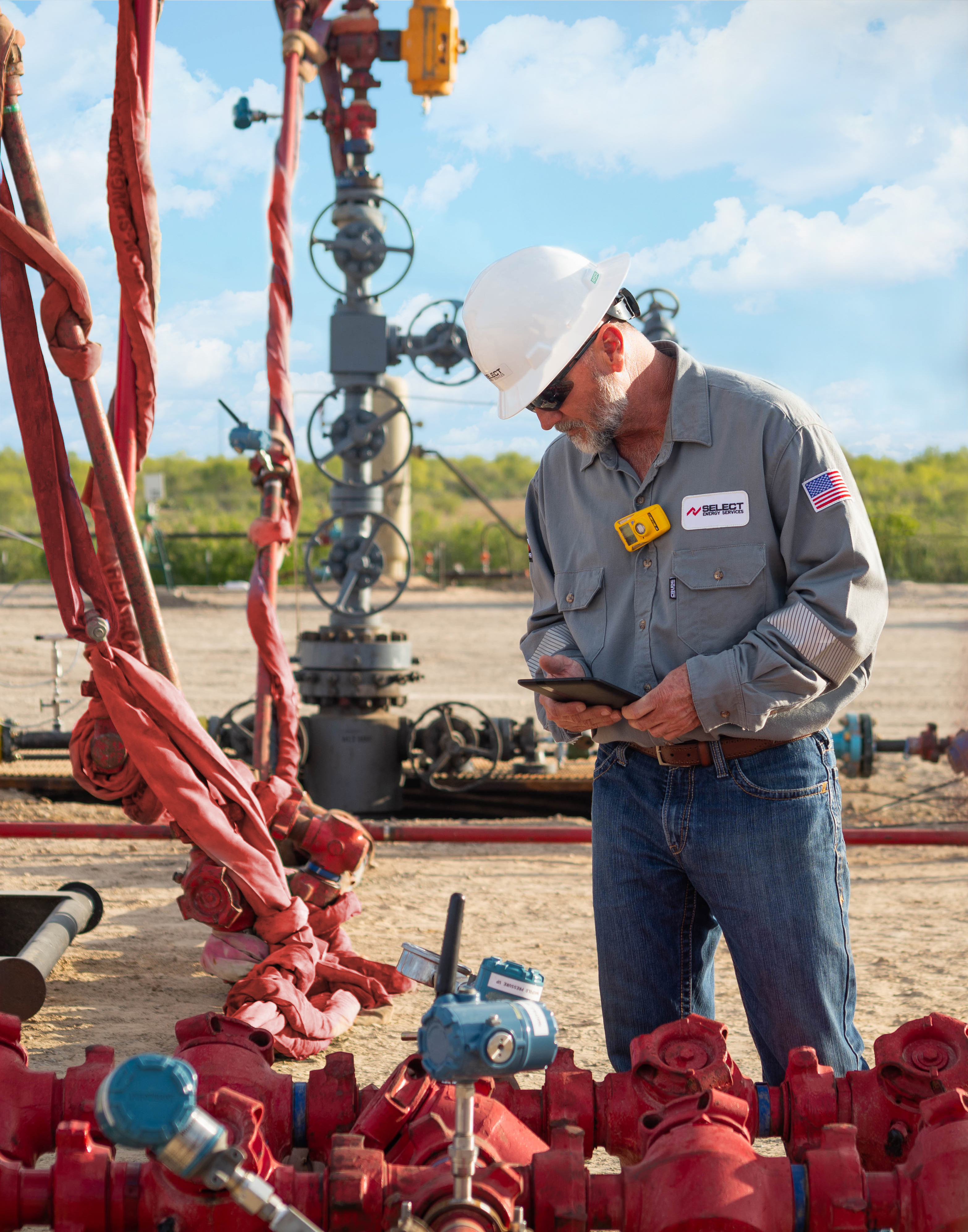
(Source: Select Energy Services)
[Editor's note: This story originally appeared in the January 2020 edition of E&P. Subscribe to the magazine here.]
The Industrial Internet of Things (IIoT) is changing the face of many industries, with readily available data at the forefront of process decisions. The vast amount of data collected, when organized and displayed in a manner that makes process decisions seamless, provides a significant opportunity to enhance safety, productivity and compliance with regulatory agencies. Well testing and flowback is one area in the well life cycle poised to benefit from these innovative data collection methods. Services that collect and organize post-frac monitoring data for operators are expected to contribute to a safer work environment for flowback operators, assist with the production of oil through automated choke adjustments and pinpointed choke change schedules, and produce digital and printable reports that operators can submit to regulatory agencies.
Too many, too far and too late
With the dynamic environment of a well site, a flowback operator must regularly track sensor information to keep the fluids balanced while flowing from the wellhead to the tank. Even a simple post-frac monitoring pad can require more than 20 sensors—each performing various functions across several square yards of piping, valves and equipment, generally residing in a Class 1, Division 2 hazardous environment. Many sensors are out of sight and out of reach for a flowback operator overseeing the equipment. Tank level monitoring of storage tanks presents a multitude of safety concerns for a flowback operator, including slips, trips and falls, and the risk of exposure to H2S, hydrocarbons, benzene, etc. The work environment brings flowback operators within a few feet of pipes under extreme pressure, upward of 5,000 psi as monitored by pressure gauges. Temperature sensors are placed on pipes that may exceed 250 F. The safety concerns for a flowback operator are painfully obvious; however, periodic reading of these sensors is paramount to a successful flowback.
The flowback operator must have experience and understand the dynamics of the well pad to make appropriate changes to the valves and piping. Washout, spills and many other potential issues may occur on location if the flowback operator fails to track and monitor sensor data. Flowback operators are required to walk the site, navigating a path through piping and do this regularly to gather the appropriate data and manipulate the well appropriately. With such a dynamic system, process changes sometimes occur long before the flowback operator has access to that information. Tanks can overfill and spill without warning if the workers are actively engaged on a separate area of the pad. Shut-in pressure may elevate beyond safe operating levels long before a flowback operator would notice if they are reading another gauge elsewhere on location.

“Collecting post-frac monitoring data from these various sensors to display in a user-friendly interface can significantly improve the job functions of flowback operators,” said Steve Smith, president of flowback and well testing for Select Energy Services. “Advancements in wireless technology, such as the WirelessHART protocol and increased coverage in cellular communications, have led us to develop our Post-Frac Monitoring [PFM] system. While periodic readings of sensors can allow for a more safe and productive site, we anticipate further improvements in productivity by adding datapoints with continuous logging to respond to changing well conditions on a real-time basis.”
Bringing it all together
Every pressure gauge, thermocouple and level display has a digital counterpart. On a well site, having a web of wires run across the site from each of the instruments was simply not feasible. This would increase the presence of operating hazards, and the associated risks far outweigh the rewards of having these sensor data. Additionally, placing a programmable logic controller (PLC) with local sensor input at every component on a well pad is cost-prohibitive.
“Accordingly, the PFM system utilizing WirelessHART sensors spread across a well site will collect sensor data without the need for multiple PLCs and miles of wires laid across the well pad or precariously taped to the piping across the site,” said Cole Hairston, vice president of flowback and well testing at Select Energy Services. The PFM system consists of a single PLC and wireless gateway to receive data from up to 100 sensors. Data and information from every component engaged in the flowback process, from the wellhead to the tanks, is read and logged by the PLC in real time. Pressure readings for every location, flow rates of oil, gas and water, and the temperature of each fluid are centralized from this PLC to a custom developed SCADA system.
A flow of data
Having access to extensive data is only beneficial for improving production if the data are meaningful. Flowback service providers will need to further define this meaning through proprietary processing and analysis of data to improve the production on a well site. As these sensor data are collected at the PLC, data relayed to command centers are organized into a database to create actionable reports and visualization.
Through the use of cloud-based data systems, visualization software and a SCADA system, data collected from the multitude of sensors can be presented in an operator-friendly format. Visualization is cross-platform, up-to the-minute and historical. Not only can the flowback operator see what is currently happening, the information is presented with several hours of historical graphs displaying historical readings of the applicable sensors. The trending capabilities of this information show the flowback operator how production is moving, allowing better responses to onsite conditions. Furthermore, process alarms can be set to notify an operator of adverse or potentially adverse conditions. These conditions could include advance notice of tank overfills resulting in lost production and regulatory infractions, pressure dips and spikes resulting in improper flowback and conditions that could lead to shut-in situations.
A cloud-based computing platform was chosen for its reliability and scalability in dealing with large datasets.
“Utilizing this service allows Select Energy Services to build regulatory compliance reports for customers, without the need to maintain handwritten records of the sensor data,” Smith said. “This service provides a constant stream of data with up-to-the-minute historical sensor data for each of the devices on a well site, without the risk of overloading a local server.”
The SCADA system provides reliable and scalable supervisory oversight as well as visualization software with an interface for everyone who needs to view the information from the PFM system. SCADA systems are offered as a web-based service, with multiple devices capable of connecting to view and act upon the data from the site. Whether this is a cellular-based tablet computing device or a desktop connected to the internet, the information is automatically presented in an organized and efficient manner.
Moving forward
The collection of process information is the first step in post-frac automation. Advancements in the IIoT have resulted in machine learning capabilities that can analyze large datasets and determine process automation rules based on the cause and effect of a variety of inputs to the system. Machine learning algorithms will allow post-frac companies to analyze the data that are collected on multiple sites and further develop automation capabilities to take action in the event of abnormal conditions on the well site. This will decrease the response time to maintain desired pressure and flow rates, increasing the production reliability of the well test. Flowback operators armed with more meaningful information to see the larger picture of the well site at a glance will increase production capabilities in a safe and responsive environment.
Recommended Reading
Civitas, Prioritizing Permian, Jettisons Non-core Colorado Assets
2024-02-27 - After plowing nearly $7 billion into Permian Basin M&A last year, Civitas Resources is selling off non-core acreage from its legacy position in Colorado as part of a $300 million divestiture goal.
Is Double Eagle IV the Most Coveted PE-backed Permian E&P Left?
2024-04-22 - Double Eagle IV is quietly adding leases and drilling new oil wells in core parts of the Midland Basin. After a historic run of corporate consolidation, is it the most attractive private equity-backed E&P still standing in the Permian Basin?
ONEOK CEO: ‘Huge Competitive Advantage’ to Upping Permian NGL Capacity
2024-03-27 - ONEOK is getting deeper into refined products and adding new crude pipelines through an $18.8 billion acquisition of Magellan Midstream. But the Tulsa company aims to capitalize on NGL output growth with expansion projects in the Permian and Rockies.
Marketed: Foundation Energy 162 Well Package in Permian Basin
2024-04-12 - Foundation Energy Fund V-A has retained EnergyNet for the sale of a 162 Permian Basin opportunity well package in Eddy and Lea counties, New Mexico and Howard County, Texas.
US Proposes Second GoM Wind Lease Auction
2024-03-20 - Combined, the four proposed areas for offshore wind have the potential to power about 1.2 million homes if developed, according to the Interior Department.




